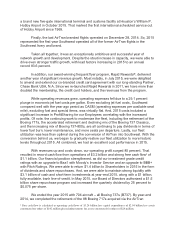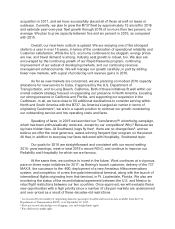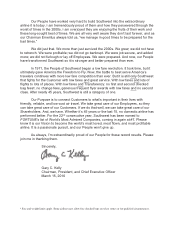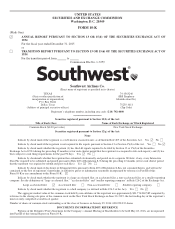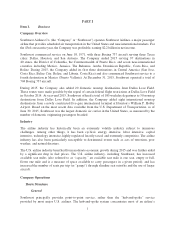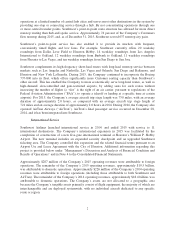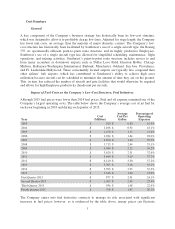Southwest Airlines 2015 Annual Report Download - page 12
Download and view the complete annual report
Please find page 12 of the 2015 Southwest Airlines annual report below. You can navigate through the pages in the report by either clicking on the pages listed below, or by using the keyword search tool below to find specific information within the annual report.
significantly in a relatively short amount of time, and the cost of hedging generally increases with
sustained high potential for volatility in the fuel market. Therefore, the Company continually monitors
and adjusts its fuel hedge portfolio and strategies to address not only fuel price increases, but also fuel
price volatility, hedge costs, and hedge collateral requirements. The Company’s fuel hedging activities
are discussed in more detail below under “Risk Factors,” “Management’s Discussion and Analysis of
Financial Condition and Results of Operations,” and Note 10 to the Consolidated Financial Statements.
During 2015, the Company continued to focus on reducing fuel consumption and improving efficiency
through fleet modernization and other fuel initiatives. The Company continued to replace its older
aircraft with newer aircraft that are less maintenance intensive and more fuel efficient. For example,
during 2015, the Company took delivery of 19 Boeing 737-800 aircraft and 24 Boeing 737-700
aircraft. In 2016, the Company currently expects to take delivery of an additional 36 Boeing 737-800
aircraft and 17 Boeing 737-700 aircraft. As further discussed in “Management’s Discussion and
Analysis of Financial Condition and Results of Operations” and in Note 1 to the Consolidated
Financial Statements, the Company recently announced its intent to accelerate the retirement of its
737-300 and 737-500 aircraft. The Company’s fleet composition and delivery schedule is discussed in
more detail below under “Properties - Aircraft.” The Company also continued to participate in
Required Navigation Performance (“RNP”) operations as part of the FAA’s Performance Based
Navigation program. RNP combines the capabilities of advanced aircraft avionics, Global Positioning
System satellite navigation (instead of less precise ground-based navigation), and new flight
procedures to produce more efficient flight patterns and conserve fuel. The Company’s RNP activities
are discussed further under “Regulation - Environmental Regulation.”
The table below illustrates the Company’s available seat miles produced per fuel gallon consumed over
the last five years:
Year ended December 31,
2015 2014 2013 2012 2011
Available seat miles per fuel
gallon consumed 73.9 72.8 71.7 69.4 68.3
Fare Structure
General
Southwest offers a relatively simple fare structure that features competitive, unrestricted, unlimited,
everyday coach fares, as well as lower fares available on a restricted basis. Southwest bundles fares
into three major categories: “Wanna Get Away®,” “AnytimeSM,” and “Business Select®,” with the goal
of making it easier for Customers to choose the fare they prefer. All fare products include the privilege
of two free checked bags (weight and size limits apply). In addition, regardless of the fare product,
Southwest does not charge fees for changes to flight reservations.
• “Wanna Get Away” fares are generally the lowest fares and are typically subject to advance
purchase requirements. They are nonrefundable but, subject to compliance with Southwest’s
No Show policy, funds may be applied to future travel on Southwest without a change fee.
Southwest’s No Show policy applies if a Customer has booked a nonrefundable fare
anywhere in his/her itinerary and that portion of the flight is not used and not canceled or
changed by the Customer at least ten minutes prior to scheduled departure. In such event,
4


